So to top your day off you just found a nail in your tire! Though it may seem like a daunting or expensive task, this article will take all the guesswork out of how to easily fix a nail in your tire. We have already done the research and are ready to help.
To fix a nail in your tire, you'll need a tire plug kit. When repairing your tire, it is first important to locate the nail and then remove the nail using vice grips or pliers. After removing the nail, quickly use the tool provided in the kit to ream out the hole the nail was in. Then plug it, threading the plug tool while physically inserting the tire plug, pushing it in until the plug is fully inside the tire! Finally, refill your tire to the prescribed pressure (usually found labeled on the driver's door).
It will be in your best interest to quickly fix your tire if it got a nail in it. In this post, we'll go into more detail on how to remedy this issue. We'll also cover other common questions when it comes to nail-related tire issues, so be sure to keep reading.
Before you continue reading, let us say we hope you find the links here useful. If you purchase something through a link on this page, we may get a commission, so thank you!
It is very important to limit your driving on your affected tire. Nails in tires pose both a risk to you as well as a risk to other drivers on the road. Punctured tires can lead to loss of vehicle control, create debris, and possibly cause a full rupture of your tire.
You should drive the absolute minimum amount on your turn before you fix the hole. Additionally, monitor your air pressure as you drive using your car's built-in sensors or by using a pressure gauge.
Check out this tire pressure gauge on Amazon.
Once you finish plugging your tire, it, unfortunately, will be your only chance to plug that tire. It is recommended by mechanics that you limit plugging your tire only once for your safety to prevent any unexpected rupturing of your tire.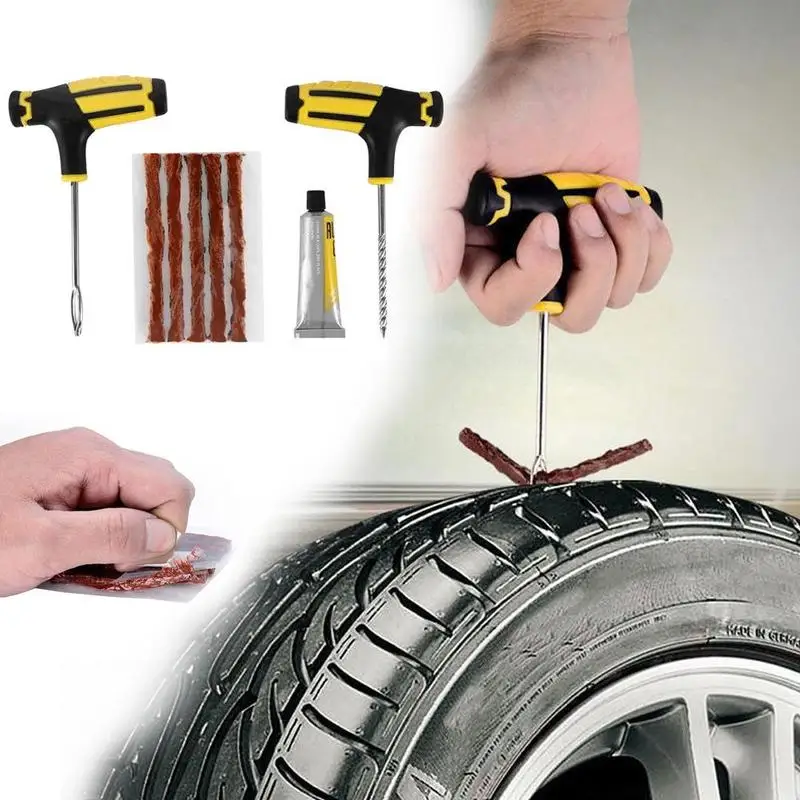 Plugging your tire should hold for the duration of the tire's life; however, occasional inspections of plug and air pressure are recommended.
Plugging your tire should hold for the duration of the tire's life; however, occasional inspections of plug and air pressure are recommended.
Plugging your tire is an easy and inexpensive fix for a nail in your tire, but should not be prioritized as the method of choice if there is substantial damage to your tire. In this case, have your car towed to a certified mechanic to ensure your safety.
If the damage to your tire is minimal and won't pose an immediate threat to you or drivers around you, use your tire plugging kit. Tire repair kits include everything you need in them, and there are plenty of options available.
See this tire repair kit on Amazon.
Once you have your kit out and ready to use, follow these steps:
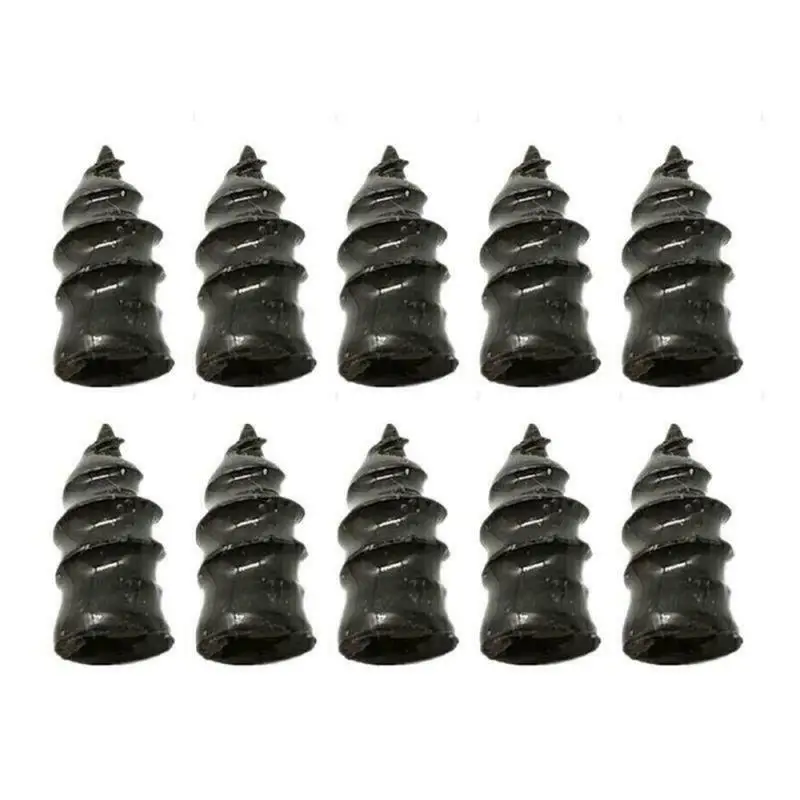 This might sound crazy to make the hole larger, but we promise it's necessary.
This might sound crazy to make the hole larger, but we promise it's necessary.As mentioned earlier, the usual cost of fixing a tire with a nail in it will run you about 10 to 20 dollars, if using a tire repair kit. How large the puncture area is will make a difference in how much these costs end up being.
Additionally, if fixing your tire on your own is not something you have time to do or feel capable of doing, you will end up paying more for these services to be done for you. Repairing your tire at a shop, on average, will cost around $20 or so - it all depends on the rates that the shop charges.
With safety in mind, the best answer to this question is that a tire will last as long as the proper air tire pressure is maintained.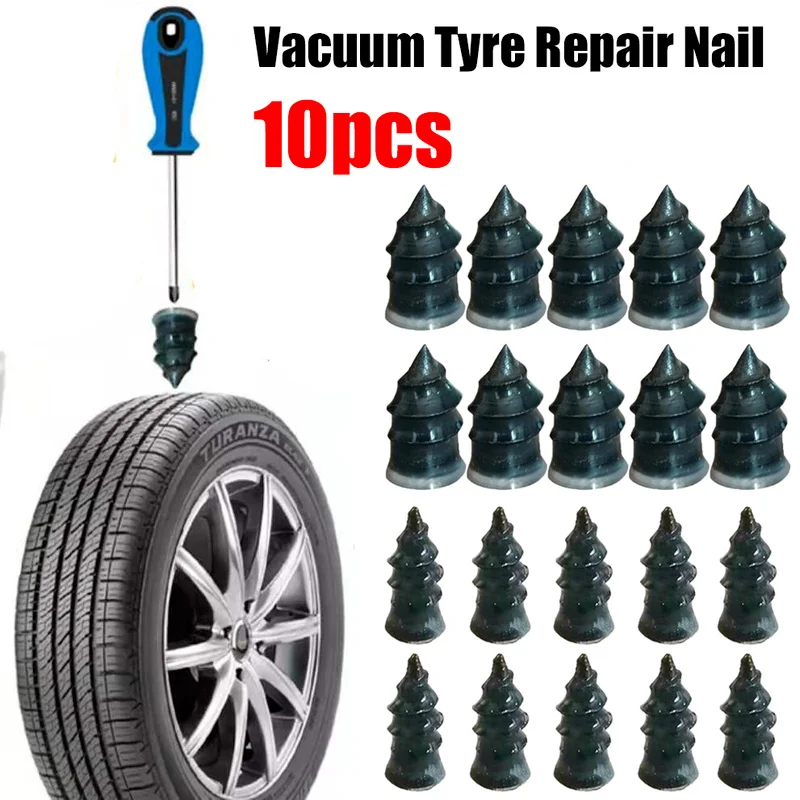 This can easily become a nuisance since larger puncture areas cause quicker air leaks in your tire. However, there are some dangers in leaving a nail in your tire so it is recommended that if you know it's there, take care of it. In some cases, the nail can lodge itself so tight in the tire that air leaking out is unlikely to happen.
This can easily become a nuisance since larger puncture areas cause quicker air leaks in your tire. However, there are some dangers in leaving a nail in your tire so it is recommended that if you know it's there, take care of it. In some cases, the nail can lodge itself so tight in the tire that air leaking out is unlikely to happen.
Nails and screws are not often found in your course of driving, whether it's on a road or a highway. You are more likely to come across a nail, or screw, or something small that poses a threat to your tire, in parking lots, construction zones, the shoulder of a road, and dirt roads.
The shoulder of the road, even on the highway, can easily become a trap for these piercing items since this is where debris and sharp rocks collect. With all this said, practice being aware and paying attention to where and through what you are taking your car.
The primary, yet temporary, solution to a slow leak in a tire is to fill your tire up with air; driving on a flat, or partially flat tire, is dangerous and can cause damage to your wheel or other parts of your car.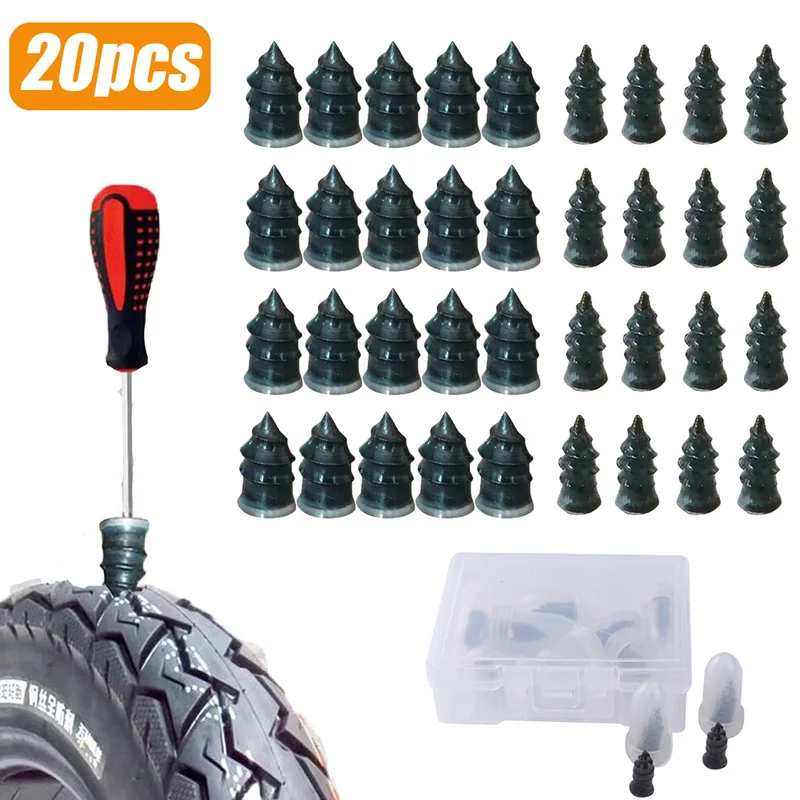 Finding where the slow leak is in your tire is the first step to what you should do. The best hack to finding this leak is as follows:
Finding where the slow leak is in your tire is the first step to what you should do. The best hack to finding this leak is as follows:
Once you have located the spot of the slow leak, it is best to seek a solution. Many newer model cars are already equipped with an aerosol sealant, which provides a quick fix and temporary solution.
For a permanent solution to a slow tire leak, you will need a plug and patch. Unless you are familiar with removing your tire and reinstalling it, it is advised that you bring your car to the shop for this one. This method requires that the tire is removed from the wheel - from here, the hole is “plugged and patched.”
If a nail pokes into the tire too close to the side wall, you are at risk of blowing out your tire if it hits a curb just right. Tires blowing out are one of the leading causes of automobile accidents. If you have noticed that a significant amount of air has leaked from the tire, do not attempt to drive. A major leak is at greater risk of a full tire blowout.
Tires blowing out are one of the leading causes of automobile accidents. If you have noticed that a significant amount of air has leaked from the tire, do not attempt to drive. A major leak is at greater risk of a full tire blowout.
Fixing a tire with a nail in it is not a difficult process, and is one that can be done by utilizing a self-repair tire plug kit. These plug kits are easy to use and once you find the nail, can be installed within 15 minutes and for minimal costs. Before you go, be sure to check out some other posts that may be of interest to you:
Driving with Low Tire Pressure (How to Do So Safely)
Can You Drive on a Flat Tire?
Ask a question, get an answer ASAP!
GET A QUOTE
Tire Patch Cost
Service Location
Price range for all vehicles
(171,627)At some point in your driving career you may walk up to your vehicle and notice the ominous glint of a nail head in the tread of your tire. It’s an uneasy feeling when you have to drive with a nail in your tire. What do you do about it? Do you need to have it fixed right away? Is the tire even leaking?
It’s an uneasy feeling when you have to drive with a nail in your tire. What do you do about it? Do you need to have it fixed right away? Is the tire even leaking?
Just because you have a nail in your tire doesn’t mean you'll have a flat tire. In some cases, the nail can be short enough that it doesn’t even penetrate through the tire’s airtight lining. In other cases, it’s trajectory may have missed the lining altogether. Or if the nail did puncture right through the liner, it may be sealed or nearly completely sealed around the offending nail. Here’s what you should do:
Always keep a tire pressure gauge in your vehicle. You should check your tire pressure every other time you fill your fuel tank. If the tire is significantly lower on pressure than it should be, put your spare tire on, or have a mechanic do it for you, and have the tire with the nail in it professionally repaired or replaced as soon as possible. If the air pressure is only slightly low, top it up and bring your vehicle to a tire repair shop to have it fixed properly.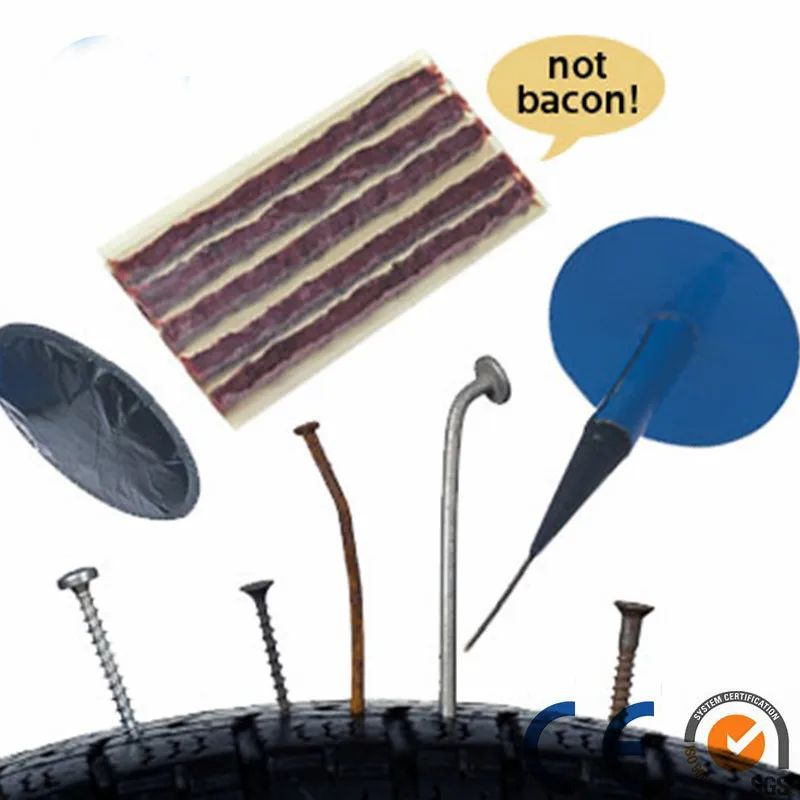
An often overlooked aspect of tire repair has to do with the steel belts inside the tire’s layers. When the tire is punctured, water, snow, and moisture can eat away at the steel belts and cause corrosion. This can compromise your tire and the belt might end up letting go and cause the tire to shimmy. Have the puncture hole repaired using a combination plug and patch, which is the only approved method of tire repair.
Unfortunately, there are areas of the tire that cannot be repaired, such as the shoulder and the sidewall. In both of these locations, there is too much flex and movement and a plug-patch will not hold. Also, if the puncture is in the tread but the hole is larger than a quarter inch, it cannot be repaired safely. Whether due to location or size, there are times that a tire repair is not possible and the tire must be replaced entirely.
Don’t take a chance driving with a nail in your tire.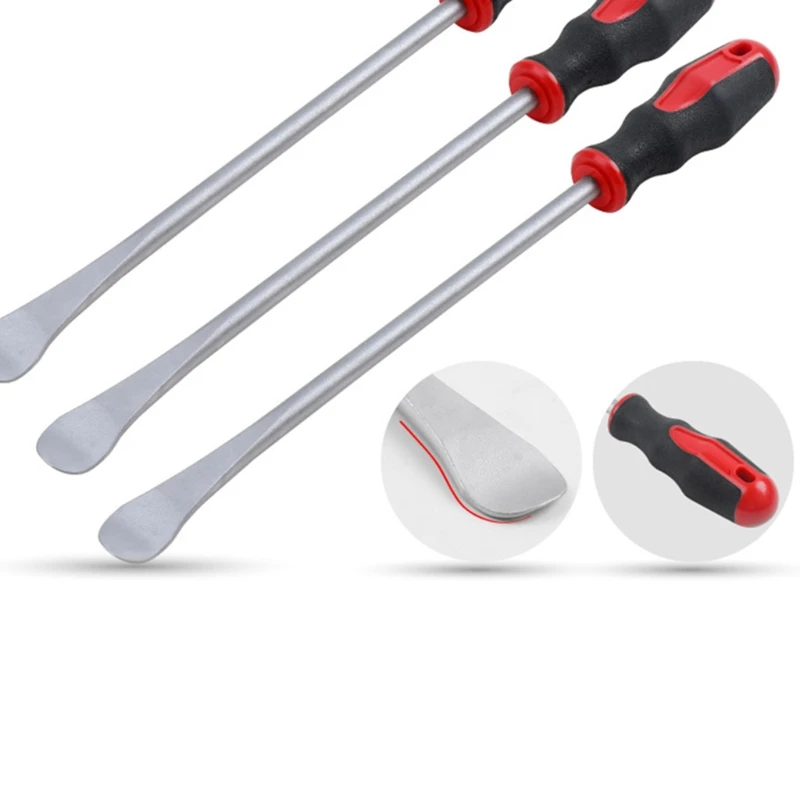 Have a professional inspect and repair your tire as soon as you can.
Have a professional inspect and repair your tire as soon as you can.
The most popular service booked by readers of this article is Tire Patch. YourMechanic’s technicians bring the dealership to you by performing this job at your home or office 7-days a week between 7AM-9PM. We currently cover over 2,000 cities and have 100k+ 5-star reviews... LEARN MORE
SEE PRICING & SCHEDULING
Tires
Tire Pressure
Puncture
Spare Tire
The statements expressed above are only for informational purposes and should be independently verified. Please see our terms of service for more details
4.2 Average Rating
Service Hours
7 AM - 9 PM
7 days a week
Phone Number
1 (855) 347-2779
Phone Hours
Mon - Fri / 6 AM - 5 PM PST
Sat - Sun / 7 AM - 4 PM PST
Address
We come to you at no extra charge
Guarantee
12-month/12,000-mile warranty
Our certified mobile mechanics perform over 600 services, including diagnostics, brakes, oil changes, scheduled mileage maintenances, and will come to you with all necessary parts and tools.
Get a fair & transparent quote instantly before booking.
(
171,627
)
161,099
161,099
SEE REVIEWS NEAR ME
21 years of experience
237 reviews
Request Richard
Richard
21 years of experience
Request Richard
by Kenneth
Acura RSX L4-2.0L - Window is not working - Bonita Springs, Florida
Great and fast service!
by Robert
Honda Civic - Camshaft Position Sensor Replacement - Fort Myers, Florida
On time and very professional and helpful
22 years of experience
2223 reviews
Request Chris
Chris
22 years of experience
Request Chris
by Gary
Jeep Grand Cherokee V6-3.7L - Oil Change - Lake Elsinore, California
On time. Excellent service as usual.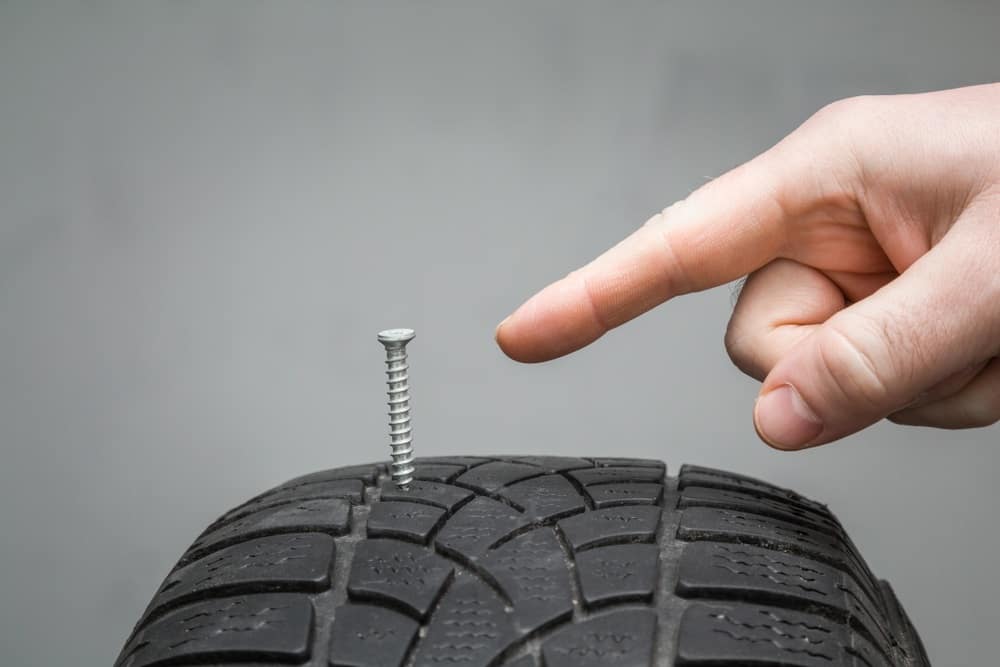
by Theodore
Volvo V40 - Starter - Irvine, California
As always, Chris did an excellent job.
21 years of experience
1068 reviews
Request Pardeep
Pardeep
21 years of experience
Request Pardeep
by Ellen
Hyundai Santa Fe V6-2.7L - Tire Patch - San Jose, California
Very quick and efficiento
8 years of experience
23 reviews
Request Nestor
Nestor
8 years of experience
Request Nestor
by Denice
Hyundai Santa Fe V6-2.7L - Tire Patch (Driver Side Front) - Boise, Idaho
Right on time, very knowledgeable and helpful on what needs to be done next. Thanks!
Our certified mobile mechanics make house calls in over 2,000 U.S. cities. Fast, free online quotes for your car repair.
GET A QUOTE
GET A QUOTE
How to Know What Tires to Buy
Your Your vehicle requires traction in order to accelerate, brake efficiently, and maintain control when you are steering.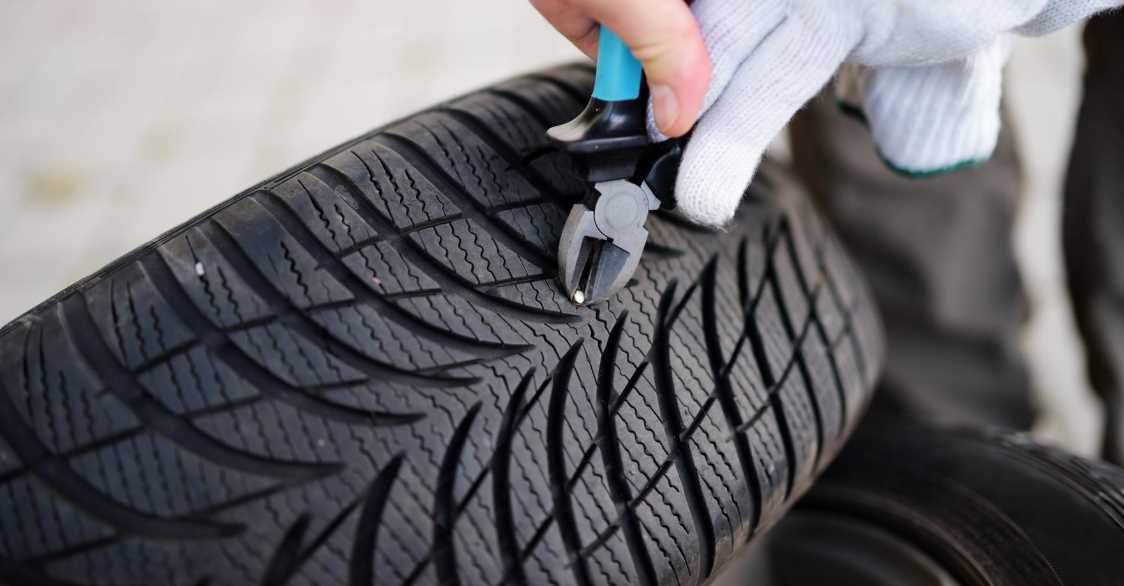 In order to do those things well, you need to own good tires on your vehicle. There are hundreds of different tire...
In order to do those things well, you need to own good tires on your vehicle. There are hundreds of different tire...
A Guide to Tire Safety
When When sitting behind the wheel of a car, there are two things that most drivers want: to reach their destination, and to do so as safely as possible. This means having a car that is in good condition, and...
How to Handle a Burst Tire
Tires burst when the tire pressure is too low or too high, there is a mechanical defect in the tire itself, or a foreign object damages the tire.
What do the service codes displayed in the Maintenance Minder™ mean?
While your Maintenance Minder™ is primarily designed to let you know when it’s time for your next oil change, it also displays codes for other needed services based on vehicle mileage. There are several different codes that can be displayed,. ..
..
P0755 & P0700 error codes
The problem with buying used tires and not having them balanced is the potential problems they can cause. Most transmissions - or more specifically, the Powertrain Control Module (PCM) which controls the transmission and drive line - contain incredibly tight...
Hi i have a 2009 dodge journey and it drives great but if you get over 70mph it starts pulsating. What could that be?
Hello, thank you for writing in. 85% of the time, when you have issues driving at high speeds, specially when you can feel them and hear them, you have an issue with your tires. The best place to start is...
Cities
Estimates
Services
Our service team is available 7 days a week, Monday - Friday from 6 AM to 5 PM PST, Saturday - Sunday 7 AM - 4 PM PST.
1 (855) 347-2779 · [email protected]
Read FAQ
GET A QUOTE
A rare motorist has not encountered the problem of a tire puncture.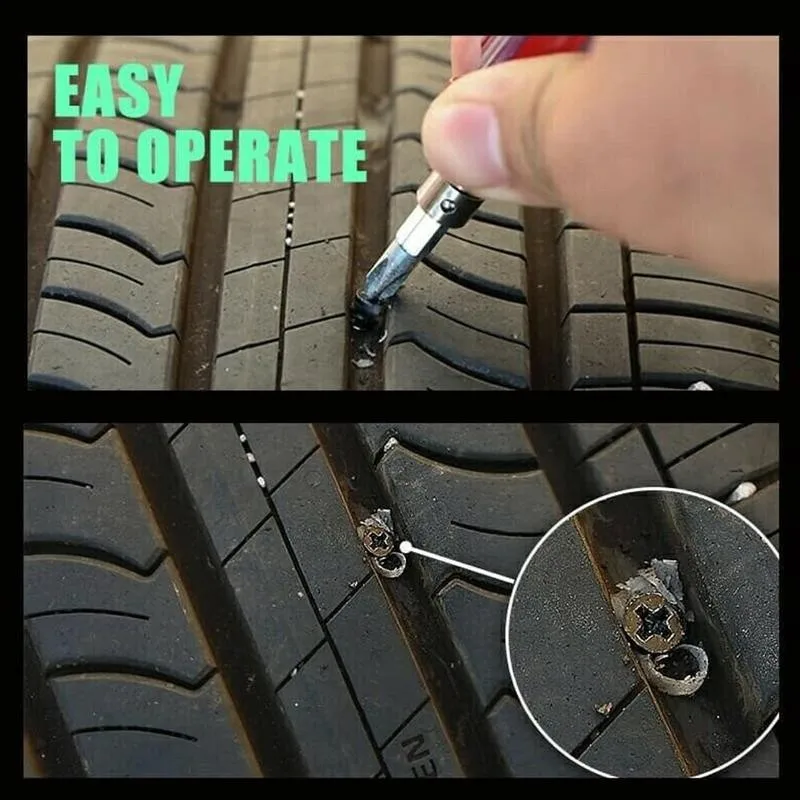 This misfortune awaits everyone and everyone, and regardless of the time of day and place. Anything can break the tightness of a tire, but most often the culprits of the breakdown are sharp nails and self-tapping screws. What action to take if a foreign object is found in the wheel?
This misfortune awaits everyone and everyone, and regardless of the time of day and place. Anything can break the tightness of a tire, but most often the culprits of the breakdown are sharp nails and self-tapping screws. What action to take if a foreign object is found in the wheel?
Sometimes you can see this..
So, first you need to assess the situation:
 If these symptoms are present, stop and inspect the wheels. It is necessary to make a decision to go to a tire shop or repair a wheel on the spot (change) based on the rate of pressure drop in the tire - if the wheel deflates quickly, then something needs to be done on the spot.
If these symptoms are present, stop and inspect the wheels. It is necessary to make a decision to go to a tire shop or repair a wheel on the spot (change) based on the rate of pressure drop in the tire - if the wheel deflates quickly, then something needs to be done on the spot. If you have a spare wheel (full-size or spare), it would be wise to replace the damaged one with it. To do this:

See this 10-minute video for a visual guide to changing a wheel
"patch" the tire in place. For this there are:
This can be done by ear, if the damage is severe - then pressure comes out of the hole with a characteristic hiss. But, there are also not significant punctures.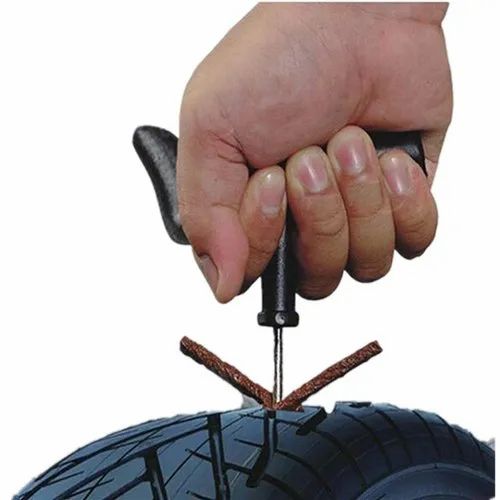 Then there are two options:
Then there are two options:
After finding the hole, you need to start patching it up.
Of course, you can try to patch the rubber yourself, but this is only to get to the tire shop ..
Use the sealant
To use the sealant:
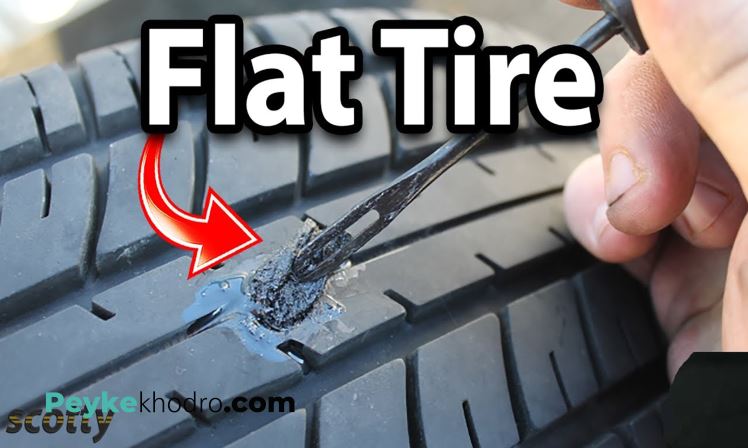
Using a rubber band
Things are more complicated with the band:
During the operation of the car, the driver runs the risk of encountering unforeseen problems.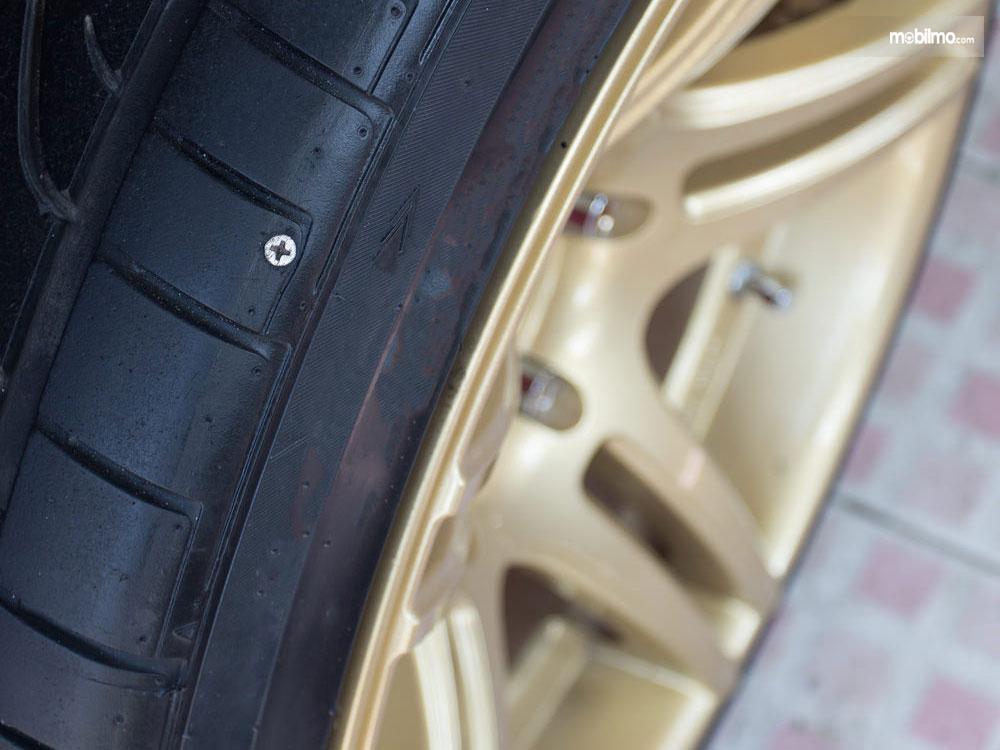 In particular, one of the situations from which no one is insured is a breakdown of the wheel by a foreign object. Often all kinds of sharp piercing objects are scattered on the road, running into which, the driver runs the risk of puncturing his tire. If the motorist is inexperienced, he can determine that a self-tapping screw, nail or other piercing object has got into the wheel only during a visual inspection, without noticing this problem while driving. Let's consider in the framework of this article what should be done in this case.
In particular, one of the situations from which no one is insured is a breakdown of the wheel by a foreign object. Often all kinds of sharp piercing objects are scattered on the road, running into which, the driver runs the risk of puncturing his tire. If the motorist is inexperienced, he can determine that a self-tapping screw, nail or other piercing object has got into the wheel only during a visual inspection, without noticing this problem while driving. Let's consider in the framework of this article what should be done in this case.
Contents:
It is quite difficult to notice that a screw, nail or other piercing element has got into the wheel. In the process of movement, a non-critical breakdown of the wheel can be determined by a characteristic knock coming from the side of the tire.
Please note: If one of the front wheels is punctured, the car will begin to “drag” in its direction while driving.
Often, drivers are faced with such a situation that when they visually inspect the tire, they find the presence of a self-tapping screw or other piercing element in it, but the wheel itself does not deflate. Many drivers make the mistake of believing that this is an acceptable situation and that no action should be taken. But such an opinion is erroneous.
Self-tapping screw, having pierced the wheel, does not lower it because of its “cap”. But there is a great risk that in the process of movement it will simply fall inward or the “cap” itself will break off. When the vehicle is moving at high speed, this can lead to a sharp change in course and an emergency. Accordingly, it is impossible to leave a self-tapping screw in the wheel.
As soon as you discover that a screw or nail is sticking out of the wheel, you should take one of the following actions:
Let's take a closer look at the steps you need to take to repair a car tire using a repair kit:
At this point, independent tire repair work can be considered completed. It is worth noting that it will take no more than 10 minutes to complete such a procedure, if you have a repair kit, and you can perform work, including in “field” conditions, for example, on the highway.
It is worth noting that it will take no more than 10 minutes to complete such a procedure, if you have a repair kit, and you can perform work, including in “field” conditions, for example, on the highway.
But besides this, the rubber can be damaged by stones, screws, self-tapping screws, nails and other sharp objects that can punch a hole in the tire. In this case, you will have to repair the wheel. But the question is: is it necessary to go to a tire fitting immediately after a wheel puncture with a self-tapping screw or a nail, or can you wait with the repair?
Everything here, of course, depends on the size of the screw or nail and how deep it went into the rubber. But in any case, regardless of the situation with a puncture, you should visit a tire shop as soon as possible to repair the wheel. You can also. True, in this case it can only be a temporary measure. The fact is that in order to make a quality tire repair, you still better contact a tire service.
So let's imagine that you punctured a wheel by catching a screw or a nail. Here is what you should do:
Here is what you should do:
If you don't have a tire repair kit, you'll have to fit a spare tire. If you don't have a spare tire, call a tow truck or call a company that provides mobile tire services. True, the cost of such services will be several times more expensive than conventional tire fitting.
If you don't have a spare tire, call a tow truck or call a company that provides mobile tire services. True, the cost of such services will be several times more expensive than conventional tire fitting.
A rare car enthusiast has not encountered the problem of a tire puncture. This misfortune awaits everyone and everyone, and regardless of the time of day and place. Anything can break the tightness of a tire, but most often the culprits of the breakdown are sharp nails and self-tapping screws. What action to take if a foreign object is found in the wheel?
Sometimes you can see this..
So, first you need to assess the situation:0011 The first option - when a puncture is detected in the morning (the wheel is fairly flat). In this case, the pressure in the tire may be extremely low or completely absent, so subsequent movement on such a tire even to the nearest service is impractical and dangerous. In addition, a flat tire can be deformed and damaged during movement - both the tire and the wheel.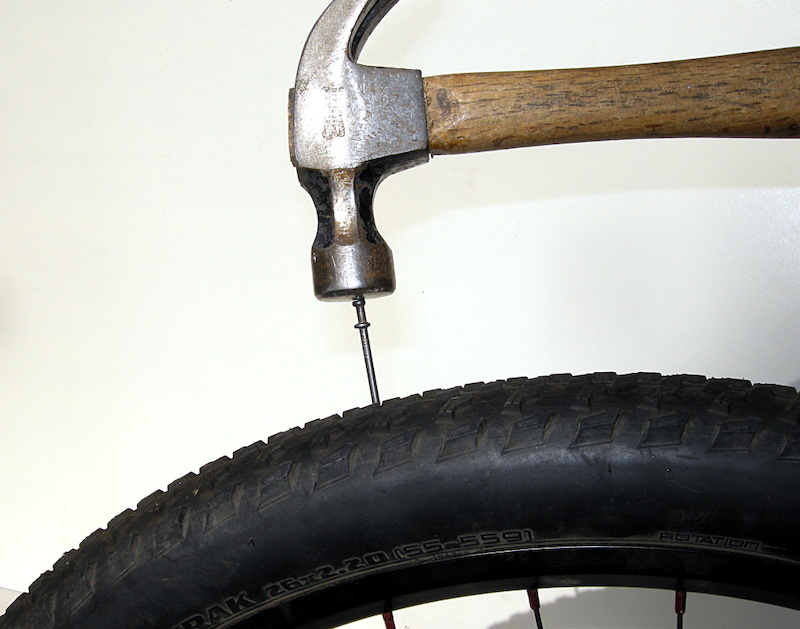
If you have a spare wheel (full-size or spare), it would be wise to replace the damaged one with it. To do this:
 It is necessary so that in case the jack is loosened, the car does not fall on the wing - the wheel will be additional insurance.
It is necessary so that in case the jack is loosened, the car does not fall on the wing - the wheel will be additional insurance. See this 10-minute video for a visual guide to changing a wheel
If there is no “spare tire” (this happens on foreign-made cars, instead of it there is a repair kit with sealant), and further movement is not possible, then you can “patch” the tire on the spot. For this there are:

This can be done by ear, if the damage is severe - then pressure comes out of the hole with a characteristic hiss. But, there are also not significant punctures. Then there are two options:
After finding the hole, you need to start patching it up.
Of course, you can try to patch the rubber yourself, but this is only to get to the tire shop ..
Use sealant
To use the sealant:
